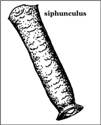Classification
Aphidinae: Aphidini
Common name(s)
Rice root aphid
Diagnosis
Apterae dark-green or olive with usually a reddish area at the posterior end of abdomen between and around siphunculi (Plate 6D). The abdomen of the alata is similarly coloured. The aphid is less hairy as compared to R. padi.
Antennae almost half the body length and 8 times as long as siphunculi. Processus terminalis six times longer than the base of last antennal segment. Siphunculi 1.7-1.8 times longer than cauda. Cauda lighter than siphunculi in younger specimens but as dark as in adults.
The aphid is generally found on the subterranean parts of the plant, and has only five- segmented antennae; however, the specimens studied had six segmented antennae and were found on subterranean as well as aerial parts. Several nymphs were found just above ground surface on the basal stem.
Distribution
Throughout the world, chiefly in warmer climates (Blackman & Eastop, 2000). Allover India.
Host plant(s)
Poaceae: Eleusine coracana (Linn.) Gaertn.
Measurements
Aptera: Length of body 2.18, width 1.37; antennae 1.11, segments III: IV: V: VI 0.24: 0.11: 0.07: (0.06+0.37); u.r.s. 0.14; h.t.2 0.11; siphunculus 0.25; cauda 0.14.
Seasonal occurrence
May-July, September-November.
Natural enemies
Coleoptera: Coccinellidae: Micraspis univittata (Hope) (=M. vincta (Gorham)).


